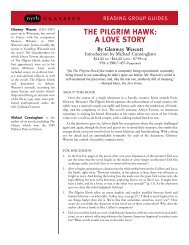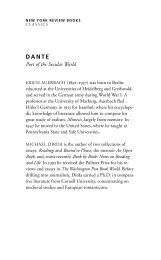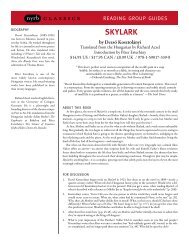Renoir, My Father Introduction - The New York Review of Books
Renoir, My Father Introduction - The New York Review of Books
Renoir, My Father Introduction - The New York Review of Books
You also want an ePaper? Increase the reach of your titles
YUMPU automatically turns print PDFs into web optimized ePapers that Google loves.
<strong>Introduction</strong><br />
with many who knew the painter, chiefly Gabrielle Renard Slade<br />
(1879–1959), who had been his childhood nurse and one <strong>of</strong> the<br />
painter’s favorite models and who was now living nearby in<br />
Hollywood. He used a tape recorder and, presumably, written<br />
notes, as the two “played the little game <strong>of</strong> taking a trip back into<br />
the past.” Gabrielle was his principal source for the period before<br />
his birth and his early years: “I hardly know which are my recollections<br />
and which are hers.” Jean also asked friends and researchers<br />
to provide him with lengthy excerpts from early writings<br />
about <strong>Renoir</strong>, and the first half <strong>of</strong> the book consists mostly <strong>of</strong> a<br />
blend <strong>of</strong> these with available biographies and histories. In addition,<br />
he used extensive writings by his father (these have only recently<br />
been published) 2 ; he quoted three pages <strong>of</strong> aphorisms from them<br />
and elsewhere paraphrased them by putting their thoughts into reconstructed<br />
conversations.<br />
<strong>Renoir</strong>, <strong>My</strong> <strong>Father</strong> has the rollicking and sometimes earthy<br />
tone <strong>of</strong> Jean’s postwar films, like French Cancan (1955) or <strong>The</strong><br />
Little <strong>The</strong>ater <strong>of</strong> Jean <strong>Renoir</strong> (1969), rather than the critical edges<br />
<strong>of</strong> his greatest films, such as Grand Illusion and <strong>The</strong> Rules <strong>of</strong> the<br />
Game (both from the later 1930s). But when the roughly chronological<br />
account reaches World War I, the book takes on a greater<br />
immediacy, perhaps because Jean’s wounded leg gave him more<br />
sympathy for his father’s condition. One can never again look indifferently<br />
at <strong>Renoir</strong>’s later portraits and paintings <strong>of</strong> nudes after reading<br />
Jean’s recollections <strong>of</strong> his father’s disastrous arthritis. Despite<br />
his infirmity, <strong>Renoir</strong> would only rarely pause from painting and<br />
then—this is the filmmaker writing—<br />
vi<br />
Darkness would invade the studio in the Boulevard Rochechouart,<br />
helping him to drift back into the past. I would take<br />
advantage <strong>of</strong> the interval to lift him up and hold him firmly<br />
while Grand’ Louise refilled his rubber cushion with air.<br />
<strong>The</strong>n, with the utmost care, we would lower him into his<br />
chair and settle him in the best position. ‘What nasty material<br />
rubber is! Give me a cigarette, will you?’ He drew a few<br />
puffs, than let it go out.<br />
2. Nature’s Workshop: <strong>Renoir</strong>’s Writings on the Decorative Arts, edited by Robert L.<br />
Herbert (Yale University Press, 2000).






